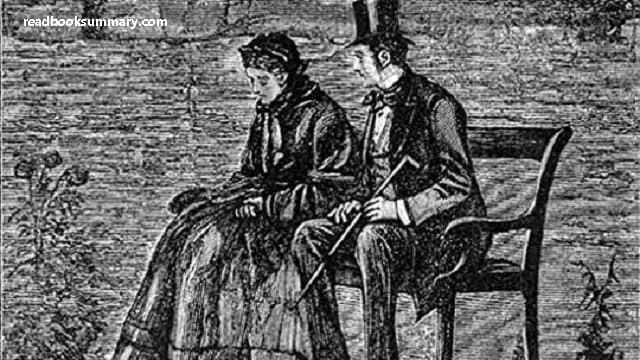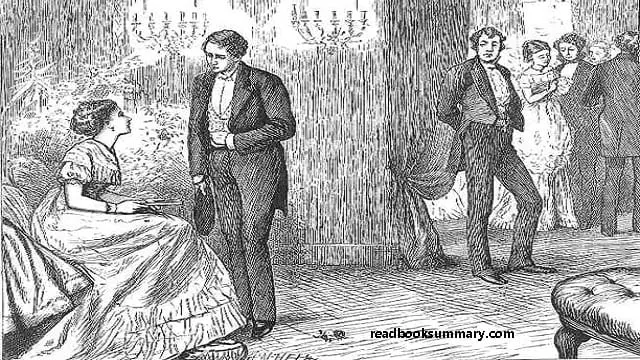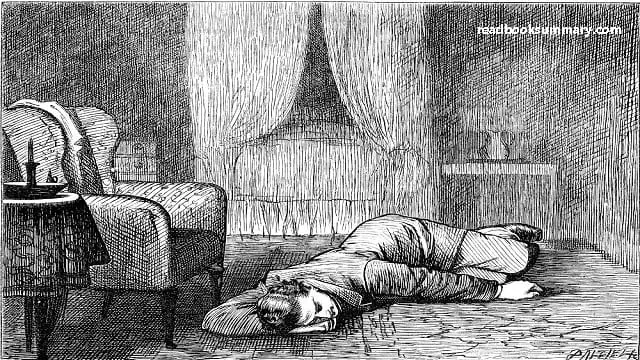Great Expectations Summary. it is the thirteenth novel by Charles Dickens and his penultimate completed novel. It depicts the education of an orphan nicknamed Pip (the book is a Bildungsroman, a coming of age story). It is Dickens' second novel, after David Copperfield, to be fully narrated in the first person.
Great Expectations Book was first published as a serial in Dickens's weekly periodical All the Year Round, from 1 December 1860 to August 1861. In October 1861, Chapman & Hall published the novel in three volumes.
 |
| Great Expectations Summary |
Great Expectations Summary
Great Expectations tells the story of an orphan named Philip Pirrip, or Pip. Pip lives with his tyrannical older sister, Mrs. Joe Gargery, and her gentle husband, a blacksmith named Joe Gargery. Joe is Pip’s closest friend.
Pip finds many ways to improve his life. He seeks further education from Biddy, a relation of his teacher’s. And he begins visiting the home of a wealthy, eccentric old spinster named Miss Havisham. At Miss Havisham’s, Pip falls in love with her adopted daughter, the haughty and beautiful Estella. Miss Havisham encourages this infatuation, but Estella does not reciprocate.
When Pip comes of age, he begins working at the forge. There, he works with a violent man named Dolge Orlick. After an argument, Orlick attacks Pip’s sister, leaving her an invalid. Soon after, London lawyer Mr. Jaggers reveals that Pip has received a large inheritance from an anonymous benefactor, whom Pip suspects to be Miss Havisham.
Pipe becomes a London gentleman, studying under a tutor named Matthew Pocket. He rooms with Matthew’s son, Herbert, and the two become fast friends. Herbert reveals that a conman broke Miss Havisham’s heart, causing her eccentricities.
Pip begins to look down on his humble beginnings. He returns home after his sister’s death and realizes that he’s been neglecting Biddy and Joe. Back in London, a convict who Pip helped escape from prison at the novel’s open, returns. The convict, Abel Magwitch, reveals that he is Pip’s mysterious benefactor.
Magwitch made a fortune in Australia and was so thankful to Pip for his kindness that he was determined to repay him. Magwitch is still on the run and reveals that he used to be partners with a conman named Compeyson. Pip and Herbert deduce that Compeyson is Miss Havisham’s former conman fiancé.
Pip confronts Miss Havisham about leading him on concerning Estella. He learns that Estella is engaged to marry his wealthy classmate, Bentley Drummle. Miss Havisham feels regret about raising Estella to be heartless and begs Pip for forgiveness.
As Pip is leaving, Miss Havisham accidentally sets her dress on fire and is badly burned. She eventually dies from her injuries. Soon after, Orlick lures Pip to the marsh and attempts to bludgeon him with a stone hammer, but Herbert and the townspeople arrive, rescuing Pip.
To help Magwitch escape, Herbert and Pip row him down the River Thames. Compeyson and the police intercept them. As the police boat approaches, Magwitch lunges for Compeyson, and the two struggle in the river. Compeyson drowns, and the court sentences Magwitch to death. Pip loses his inheritance.
As he slips further into debt, Pip becomes very ill. Joe comes to London to nurse Pip and pay off some of his debts. Joe also brings news from home: the police arrested Orlick for robbery; Biddy has taught Joe to read; and Miss Havisham divided her will among Estella, Herbert’s father, and Pip. Pip returns home to marry Biddy, only to discover that Joe has married her. Pip decides to work with Herbert in Egypt.
After many years abroad, Pip returns to England. He visits the site of Miss Havisham’s demolished house. There, he finds a recently widowed Estella. Estella’s bitter marriage has made her a kinder person. The novel ends with Pip and Estella walking hand-in-hand.
You may also like to read: Of Mice and Men Book Summary
Great Expectations Themes
Social Class and Social Mobility: The novel is deeply critical of Victorian England's rigid class system, which limited opportunities and perpetuated inequality, Pip's journey from poor orphan to gentleman reveals the challenges and limitations of social mobility, Characters like Miss Havisham and Magwitch embody the destructive effects of social climbing and obsession with status.
Ambition and Self-Improvement: Pip's initial aspirations to rise in social standing are fueled by a misguided sense of ambition and snobbery. As he matures, he learns that true self-improvement comes from developing empathy, compassion, and moral integrity. The novel suggests that happiness and fulfillment are not found in wealth or status, but in genuine human connection and self-acceptance.
Love and Deception: Pip's infatuation with the cold and unattainable Estella leads him to betray his own values and neglect those who truly care for him. The novel explores the complexities of love, desire, and the dangers of illusion. Ultimately, Pip learns that true love is grounded in mutual respect, understanding, and shared experiences.
Guilt and Redemption: Pip struggles with guilt and shame over his treatment of Joe and other characters. The novel suggests that redemption is possible through self-awareness, taking responsibility for one's actions, and offering genuine remorse. Characters like Magwitch and Miss Havisham demonstrate the destructive consequences of clinging to the past and refusing to forgive themselves or others.
Justice and Morality: The novel raises questions about the nature of justice, particularly in the context of the criminal justice system. Pip's encounters with convicts like Magwitch challenge his simplistic ideas about right and wrong. The novel ultimately suggests that true justice requires empathy, understanding, and a commitment to fairness and compassion.
You may also like to read: Great Expectations Book Quotes
 |
| synopsis of great expectations |
 |
| great expectations plot summary |
 |
| great expectations chapter summaries |
 |
| great expectations synopsis |
 |
| great expectations short summary |
Questions and Answers about Great Expectations Plot
What is the main point of Great Expectations? The moral theme of Great Expectations is quite simple: affection, loyalty, and conscience are more important than social advancement, wealth, and class.
What is the summary ending of Great Expectations? Author Wilkie Collins convinced Dickens to write another ending for the novel. The original ending has Estella remarrying and Pip remaining single. However, the revised ending ends with Pip and Estella together. This revised ending is considered the canonical, or official, ending to the novel, Dickens conceived of Great Expectations as a means of restoring his publications fortunes. The book is still immensely popular a century and a half later. Read more about Dickens's previous serialized novel, A Tale of Two Cities.
Why did Charles Dickens wrote Great Expectations? Dickens conceived of Great Expectations as a means of restoring his publications fortunes. The book is still immensely popular a century and a half later. Read more about Dickens's previous serialized novel, A Tale of Two Cities.
What is the main conflict in Great Expectations? The major conflict of Great Expectations revolves around Pip's ambitious desire to reinvent himself and rise to a higher social class.
What are the symbols of the Great Expectations? In Great Expectations, the most important symbols to the narrative are the rising mists, locks and keys, the Satis house, London, and Miss Havisham's wedding cake.
What is the last sentence in Great Expectations? 'I took her hand in mine, and we went out of the ruined place; and, as the morning mists had risen long ago when I first left the forge, so, the evening mists were rising now, and in all the broad expanse of tranquil light they showed to me, I saw no shadow of another parting from her.
What happened to Pip's Great Expectations? Pip decides to go abroad with Herbert to work in the mercantile trade. Returning many years later, he encounters Estella in the ruined garden at Satis House. Drummle, her husband, treated her badly, but he is now dead.
What is the theme of revenge in Great Expectations? Great Expectations explores the way in which past injustices motivate Magwitch and Miss Havisham to manipulate the innocent Pip and Estella into becoming forms of vengeance on society, a vengeance which initially reverses into the corruption of the children by that same society, but is finally atoned for.
Who is the villain in Great Expectations? Compeyson is the main antagonist of Charles Dickens' novel Great Expectations, a 'George Wickham'-esque man, whose criminal activities harmed two people, who in turn shaped much of protagonist Pip's life. Compeyson abandoned Miss Havisham at the altar, and later got Abel Magwitch arrested.
Who is the most tragic character in Great Expectations? Miss Havisham's life is defined by a single tragic event: her jilting by Compeyson on what was to have been their wedding day. From that moment forth, Miss Havisham is determined never to move beyond her heartbreak.
Why did Dickens change the ending to Great Expectations? Because Great Expectations was serialized, Dickens was writing his "episodes" several weeks in advance. He took his friend's advice and rewrote his ending in a way that suggests that Pip and Estella will be together, but he did it in a way that preserves the original ending's melancholy and uncertainty.
What is the irony in the Great Expectations? Great Expectations mostly employs the use of situational irony, where both the reader and the characters in the story are unaware of certain realities. For example, Estella, the ultimate snob, turns out to be the daughter of a gypsy and a convict.
What literary element is Great Expectations? The metaphors and figurative language used in Charles Dickens' ~'Great Expectations~' include personification, hyperbole, irony, and simile. Learn more about these literary tools and examine metaphors from the novel.
Does Pip become a gentleman? In the novel “Great Expectation” by Charles Dickens, the main character Pip grows and develops into a young gentleman, who learns many valuable life lessons about himself. Along his path of development, Pip's knowledge and growth are influenced by his friends and family who act as his guardians.
